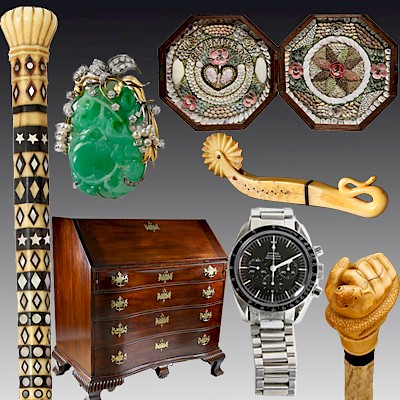CHIPPENDALE MAHOGANY REVERSE SERPENTINE SLANT-FRONT DESK, ATTRIBUTED TO WILLIAM KING, SALEM, MASSACHUSETTS
Lot 53
About Seller
Rafael Osona Auctions
21 Washington St. , P.O. Box 2607
Nantucket, MA 02584
United States
Recognized since 1980 as a premier dealer in 18th – 21st century Antiques and Arts, our family owned, full service auction house conducts more than a dozen unique auctions annually, reaching regional and global buyers. We showcase exceptional decorative and fine arts in every category. Rafael Osona ...Read more
Estimate:
$7,000 - $10,000
Absentee vs Live bid
Two ways to bid:
- Leave a max absentee bid and the platform will bid on your behalf up to your maximum bid during the live auction.
- Bid live during the auction and your bids will be submitted real-time to the auctioneer.
Bid Increments
| Price | Bid Increment |
|---|---|
| $0 | $25 |
| $250 | $50 |
| $500 | $100 |
| $1,000 | $250 |
| $5,000 | $500 |
| $10,000 | $1,000 |
| $20,000 | $2,500 |
| $50,000 | $5,000 |
| $100,000 | $10,000 |
| $200,000 | $25,000 |
| $500,000 | $50,000 |
About Auction
By Rafael Osona Auctions
Aug 3, 2019
Set Reminder
2019-08-03 09:30:00
2019-08-03 09:30:00
America/New_York
Bidsquare
Bidsquare : August 3, 2019 Americana, Fine Art, Marine Auction
https://www.bidsquare.com/auctions/osona-auctions/august-3-2019-americana-fine-art-marine-auction-4274
August 3rd Americana, Fine Art, Marine Auction Rafael Osona Auctions info@rafaelosonaauctions.com
August 3rd Americana, Fine Art, Marine Auction Rafael Osona Auctions info@rafaelosonaauctions.com
- Lot Description
CHIPPENDALE MAHOGANY REVERSE SERPENTINE SLANT-FRONT DESK, ATTRIBUTED TO WILLIAM KING, SALEM, MASSACHUSETTS, circa 1775, the oblong thumb-molded lid opens over lopers to create a writing surface and to disclose a stepped arrangement of six drawers centering an arcade of six pigeonholes; the generously proportioned case is fitted with four graduated long drawers of 'ox bow' profile above a molded base supported on gadrooned ogee bracket feet centering a shell-carved pendant.
Height 43 in. Width 41 in. Depth 25 in.
Woods: Mahogany, white pine secondary
Hardware: The brasses and escutcheons have been replaced. In the interior the small drawers once had drop loop handles but these have been replaced with knop pulls.
Surface: Retains an old 19th century surface.
Restoration: The lid is lipped along the top and sides and the hinges are patched where broken out. Small amount of cockbeading replaced. Drawer runners have been flipped but appear to be original. Lower left front foot facing old repair. Left rear glue block missing.
Provenance: Wayne Pratt, Woodbury, Connecticut; Garth's Auction Company, Delaware, Ohio, The Estate of George C. Samaha, October 9, 1971; George C. Samaha, Milan, Ohio
Notes: Born February 24, 1754, William King married Rebecca Phippen, the daughter of Salem Deacon Nathaniel Phippen, and first advertised July 21, 1789 in the Salem Mercury. From surviving accounts, he appears to have been quite a character. Soon after 1789, he stole a horse and buggy with the intention of deserting his family but was apprehended in New Haven. In 1793, he abandoned his family again. The diary of the Reverend William Bentley, dated July 3, 1796, notes: News from Philadelphia that William King belonging to a good family in this Town after having dragged his family from Town to Town, left a note that he was going to drown himself and disappeared. It is supposed that he means to ramble unencumbered. The family are to return to Salem. King reappeared again in Hanover, New Hampshire when he advertised in 1806. He is not known to have returned to Salem. (Ethel Hall Bjerkoe, The Cabinetmakers of America, Garden City, New York, 1957, p. 138).
Three known pieces are known to survive that bear his name: a serpentine-fronted chest of drawers with his paper label sold at Christie's New York, January 24, 2014, lot 135; an oval-top mahogany candlestand with pad feet branded "W. King" on the underside of the urn pedestal, sold by Sotheby's, New York, November 18-20, 1976, lot 960 and illustrated in Israel Sack, American Antiques from Israel Sack Collection, vol. II, no. 744; and a demilune card table with fluted straight legs and bearing what appears to be a label identical to that on the previously mentioned chest sold at Skinner, Inc., Bolton, August 12, 2000, lot 131. A chest-of-drawers in the collection of the Peabody Essex Museum that features a gadrooned base is attributed to King (Decorative Arts Photographic Collection (DAPC), Winterthur Library, no. 65.4151).
Source: Christie's New York
Literature: For discussions of similar case pieces attributed to William King see articles in Antiques Magazine, September 1927 and November 1944.Items may have wear and tear, imperfections or the effects of aging. Please contact the gallery for further details prior to bidding. Any condition statement given as a courtesy should not be treated as fact.Condition
- Shipping Info
-
Please visithttps://www.rafaelosonaauction.com/buying/shipping/ for information regarding the collection and shipping of items purchased at auction.
-
- Buyer's Premium



 EUR
EUR CAD
CAD AUD
AUD GBP
GBP MXN
MXN HKD
HKD CNY
CNY MYR
MYR SEK
SEK SGD
SGD CHF
CHF THB
THB















